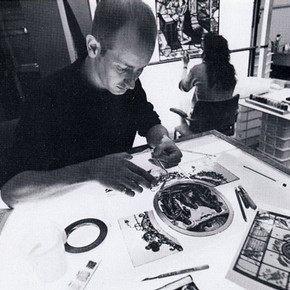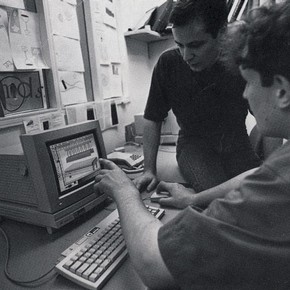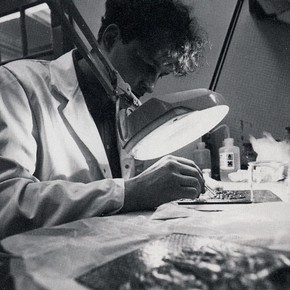Conservation Journal
January 1992 Issue 02
RCA/V&A conservation course: training & research options for 1992-3
The RCA/V&A Conservation Course offers a range of specialised practical conservation and research opportunities for each new academic year. The options change from year to year and those available in any year depend primarily on the availability of staff, facilities and resources within the Conservation Department. In some cases, however, the involvement of curatorial staff in the V&A and of colleagues in other institutions may be essential. The organisation for any particular 'target' discipline or research project is therefore complex and unfortunately, the options for a particular year can not usually be resolved by the copy date for the College prospectus. The only solution is to produce, each November, a separate list of options which is essential information for anyone interested in applying for the Course alongside the relevant pages in the 1992/3 RCA Prospectus. This list is distributed as far as possible both within the profession and to art schools, polytechnics and universities but the potential 'catchment area' is so huge that there will always be very large parts which fail to be reached.
It is clear from experience that the word reaches the best potential students via conservators and curators who have them-selves received enquiries about training. This makes the Journal a potentially useful medium for distributing information about the opportunities available in association with the Course (as opposed to Conservation Department internships, which are dealt with separately). The intention is to include regular items outlining plans as far in advance as possible. The following notes reflect this intention though on this occasion it has to be said that the timing is not ideal. The closing date for applications is officially in mid-February by which time many readers will only just be receiving this issue.
Potential candidates should not, however, be dissuaded from contacting us after the deadline. It is invariably extended and as the formal interviews do not take place until mid-March, even very late applications can sometimes be considered.
Not all the options are straightforwardly vocational. Some do offer a combination of studio-based and theoretical training appropriate to the intending practical conservator. Others are either entirely research-based or involve some element of training in support of project or research work. Also, it should be noted that the intention is not to take a student for every option to start in October '92. The decision as to how many students to accept and for which options will depend on the quality of applications received. No final decision will be made until all interviews have been completed but an intake of four or five students is most likely.
The current College prospectus and application forms are available from:
The Registrar
Royal College of Art
Kensington Gore
London SW7 2EU
Telephone 071 584 5020
Fax 071 225 1487
The Registry will also supply further copies of this list of options for 1992/93 if the enquiry specifically refers to the Conservation Course. Copies of the Course brochure, the list of options and more detailed information about all of the areas of specialisation avail-able with the Course are available from Alan Cummings, Conservation Course Leader at the same address. We would also be happy to hear, not only from potential students, but from colleagues in other institutions who feel there may be opportunities for collaboration in training and research.
Stained Glass Conservation
Studio-based MA, 2 or 3 years
The successful candidate will spend about 70% of his/her time engaged in conservation training and practice based on the V&A Museum collections of stained glass. Opportunities will also be provided for work-experience outside the Museum. About 30% of the Course will be set aside for formal academic tuition, private study, tutorials and assessment.
Experience in stained glass conservation or in working with glass would be an advantage but established skills are not essential. Experience in other aspects of conservation, general craft skills, scientific and historical knowledge are also an advantage.
Metals
Studio-based MA, 2 or 3 years
The organisation and content of the Course directly parallels that for Stained Glass but the successful student will be based in the Metals Section and practical work will be based on the important collections of metalwork and jewellery.
A candidate with substantial experience in metals conservation, wishing to extend his/her training at an advanced level, would be strongly preferred. For candidates without such experience or training, a sound knowledge of metalworking skills would be essential. Experience in other aspects of conservation, general craft skills, scientific and historical knowledge would also be an advantage.
Sculpture Conservation
Studio-based MA, 2 or 3 years
Again, the organisation and content of the Course directly parallels that for Stained Glass and Metals but the successful student will be based in the Sculpture Section. The V&A Museum collections of sculpture are extremely diverse and important and include a wide range of materials.
A candidate with substantial experience in sculpture conservation, wishing to extend his/her training at an advanced level, would be strongly preferred. For candidates without such experience or training, a sound knowledge of traditional carving and
modelling skills would be essential. Experience in other aspects of conservation, general craft skills, scientific and historical knowledge would also be an advantage.
Conservation Science
Laboratory-based MA, 2 or 3 years
The successful candidate will spend about 70% of his/her time engaged in training and experience within the Science Section of the V&A Museum Conservation Department. The Course will aim to cover all the activities in which museum scientists are currently involved including technical examination and photography, microscopy, instrumental methods of analysis, materials testing, monitoring and control of the environment. Opportunities will also be provided for research and for appropriate work-experience outside the Museum. About 30% of the Course will be set aside for formal academic tuition, private study, tutorials and assessment. The general content and organisation of the Course are outlined in a brochure available from the Course Leader.
The ideal candidate will be a science graduate with a strong interest in the arts or a conservation graduate with a science background. A candidate with a special interest in microscopic techniques for the identification of materials would be preferred.
The Applications of Computers in Conservation
Project-based MPhil, 2 years
The project will provide an opportunity for a student to study and develop the applications of computers in conservation. Areas of interest include:
-
Documentation procedures and database systems for large museum collections
-
Image processing, 3D modelling, use of scanners, still cameras etc. as applicable to the study and documentation of museum objects
-
Sophisticated text/2D and 3D image database sytems for smaller collections of objects
-
Expert systems for object condition assessment by conservators and non-conservators
-
The use of computers in interactive teaching for conservators - especially science for non-scientists
-
Multi-media presentations of technical and conservation data for use in gallery and exhibition space
During the first year, the successful candidate will be based partly in the Conservation Department of the V&A and partly in Computing at the RCA. This will permit familiarisation with the needs and interests of museum documentation experts, conservators, curators and collections managers and how these can be served by the IBM compatible Museum systems and the Mac environment of the College. The division of time will depend on the interests of the individual student and the availability of appropriate tuition/ supervision. During the second year, the student will undertake a full-time computing or documentation project of particular interest within one of the areas outlined above. The opportunity would suit a conservation graduate or a design graduate with a strong interest in computers or a computing graduate-with an interest in museums and the technical study of works of art.
The Application of Optical Techniques to the Examination and Documentation of Works of Art and to the Study of their Dimensional Response to Shock, Vibration and the Environment
Research-based MPhil or PhD, minimum 2 years
The project would draw on the resources of the V&A Conservation Department and the Photography, Holography and Computing Departments of the Royal College of Art in collaboration with Linhof, Zeiss, the National Gallery, the Tate Gallery, Imperial College of Science, Technology and Medicine and others.
The techniques involved may include photogrammetry, holographic interferometry, laser scanning and other methods of three-dimensional recording as applied to paintings, sculpture and other works of art and design. There may also be productive overlap between this project and the project on the applications of computers in conservation - particularly in the areas of 3-dimensional modelling and display.
After an initial period of contextual study, the student would be expected to focus his/her research on a single technique and to the study of a limited range of objects/environmental parameters. The particular area of investigation chosen will depend on the inclinations of the student, the availability of supervision, facilities and resources and the source of funding. The project could have major implications for the recording, replication, care, packing, transport and exhibition of works of art and museum collections.
The ideal student would be a graduate from a natural sciences or engineering background with a strong interest in optics and the arts, an MSc Optics graduate wishing to proceed to PhD, or a conservation graduate with a science background and a particular interest in this field.
The Urban Landscape: A Technical Study of Topographical Painting, with Special Emphasis on Views of London
(In collaboration with the Museum of London)
Research MA or MPhil, 2 years
Only two paintings survive which show London before the Great Fire of 1666. One has been recently acquired by the Museum of London and the other is in the collection of the Duke of Devonshire. They are closely related and were either copied from each other or are both after the same model. The chronology and attribution of these paintings and related prints and drawings are difficult to establish but are of considerable importance to the historian.
There are many similar problems within the field of topographical painting in general and concerning the collection of the Museum of London in particular. In addition, the technical approach of artists to the painting of the cityscape has not been studied either through available literature or through technical examination of the works themselves. There is therefore much scope for a research project which combines technical examination and art historical investigation. The range and focus of the project will be more carefully defined according to the access available to specific paintings and other primary sources, the supervision and facilities available, and the particular interests of the research student selected for the project.
The ideal candidate would be a graduate from a paintings conservation course wishing to proceed to a degree by research.
Technical Study of Paintings in the V&A Collections
Research MA or MPhil, 2 years
Following the success of Sarah Cove's project on the Materials and Techniques of John Constable (registered for PhD at the Courtauld Institute), the Paintings Section of the V&A Conservation Department have suggested that a new project may be feasible along similar lines but with registration of the student as an RCA/V&A Conservation student. Proposals are therefore r welcomed which involve the technical study of some aspect of the collection of paintings in the V&A Museum. Any such project would need the co-operation of relevant curatorial staff and of the Science Section of the V&A Conservation Department in addition to supervision from the paintings conservators and Course Leader. Individual proposals will therefore require detailed discussion prior to a formal interview.
A project devoted to the technical study of paintings would best suit a graduate from a paintings conservation course. The bias towards historical or scientific research could vary, however, according to the interests and background of the student. Art history graduates with a particular interest in techniques and materials may therefore be appropriate in some cases.
Technical Study of Picture Frames
Research MA or MPhil, 2 years
The V&A Museum possesses a large and important collection of picture frames and the value of frames as objects in their own right is increasingly recognised. The level and breadth of research, however, has not matched this recognition. There is therefore much scope for a project involving a technical study of frames in association with the Course. This project, whether it relies heavily on technical examination or to a significant extent on library-based research, would need the co-operation of curatorial staff and of the Science Section of the V&A Conservation Department. Individual proposals will therefore require detailed discussion prior to formal interview.
This project would best suit a graduate from a conservation course, particularly a student with a strong interest in gilded and other decorated surfaces, but the bias towards historical or scientific research could vary according to the interests and background of the student.
January 1992 Issue 02
- Editorial Comment - Conservation Journal 2
- An assessment of the conservation of a unicorn tapestry
- Study tour of Swedish textile conservation studios
- Report on a summer placement at the National Museum of Natural History, Washington DC
- A fibre optic video microscope
- Upholstery conservation
- Introducing ‘new methods in cleaning objects’ to the V&A
- Radiation sickness? An informal review of the restoration '91 exhibition in October
- A review of paper & textiles - the common ground
- A report on the International Symposium on the Conservation of Ceramics & Glass, Amsterdam. 2-4 September 1991
- RCA/V&A conservation course: training & research options for 1992-3


